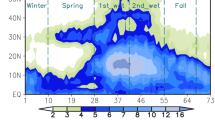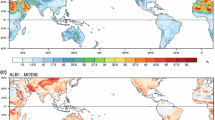Abstract
While time-slice simulations with atmospheric general circulation models (GCMs) have been used for many years to regionalize climate projections and/or assess their uncertainties, there is still no consensus about the method used to prescribe sea surface temperature (SST) in such experiments. In the present study, the response of the Indian summer monsoon to increasing amounts of greenhouse gases and sulfate aerosols is compared between a reference climate scenario and three sets of time-slice experiments, consisting of parallel integrations for present-day and future climates. Different monthly mean SST boundary conditions have been tested in the present-day integrations: raw climatological SST derived from the reference scenario, observed climatological SST, and observed SST with interannual variability. For future climate, the SST forcing has been obtained by superimposing climatological monthly mean SST anomalies derived from the reference scenario onto the present-day SST boundary conditions. None of these sets of time-slice experiments is able to capture accurately the response of the Indian summer monsoon simulated in the transient scenario. This finding suggests that the ocean–atmosphere coupling is a fundamental feature of the climate system. Neglecting the SST feedback and variability at the intraseasonal to interannual time scales has a significant impact on the projected monsoon response to global warming. Adding interannual variability in the prescribed SST boundary conditions does not mitigate the problem, but can on the contrary reinforce the discrepancies between the forced and coupled experiments. The monsoon response is also shown to depend on the simulated control climate, and can therefore be sensitive to the use of observed rather than model-derived SSTs to drive the present-day atmospheric simulation, as well as to any approximation in the prescribed radiative forcing. While such results do not challenge the use of time-slice experiments for assessing uncertainties and understanding mechanisms in transient scenarios, they emphasize the need for high-resolution coupled atmosphere-ocean GCMs for dynamical downscaling, or at least for high-resolution atmospheric GCMs coupled with a slab or a regional ocean model.













Similar content being viewed by others
References
AchutaRao K, Sperber KR (2002) Simulation of the El Niño southern oscillation: results from the coupled model intercomparison project. Climate Dyn 19:191–209
Ashrit RG, Douville H, Rupa Kumar K (2003) Response of the Indian monsoon and ENSO-monsoon teleconnection to enhanced greenhouse effect in the CNRM coupled model. J Meterol Soc Japan 81:779–803
Bhaskaran B, Mitchell JFB, Lavery JR, Lal M (1995) Climatic response of Indian subcontinent to doubled CO2 concentrations. Int J Climatol 15:873–892
Blanke B, Delecluse P (1993) Low frequency variability of the tropical Atlantic Ocean simulated by general circulation model with mixed layer physics. J Phys Ocean 23:1363–1388
Boucher O, Lohman U (1995) The sulfate-CCN-cloud albedo effect: a sensitivity study two general circulation models. Tellus 47:281–300
Bougeault P (1985) A simple parameterization of the large-scale effects of cumulus convection. Mon Weather Rev 113: 2108–2121
Côté J, Staniforth A (1988) A two-time-level semi-Lagrangian semi-implicit scheme for spectral models. Mon Weather Rev 116: 2003–2012
Camberlin P, Zhao Y, Chauvin F, Douville H (2004) Simulated ENSO-tropical rainfall teleconnections as from the ARPEGE-OPA coupled ocean-atmosphere model. Climate Dyn 23: 641–657
Carnell RE, Senior CA (2002) An investigation into the mechanisms of changes in mid-latitude mean sea level pressure as greenhouse gases are increased. Climate Dyn 18:533–543
Davey MK et al (2002) STOIC: a study of coupled model climatology and variability in tropical ocean regions. Climate Dyn 18: 403–420
Déqué M et al (1999) Documentation ARPEGE-CLIMAT (available from CNRM, Météo-France, 31057 Toulouse, France)
Déqué M, Dreveton C, Braun A, Cariolle D (1994) The ARPEGE/IFS atmospheric model, a contribution to French community climate modelling. Climate Dyn 10:249–266
Déqué M, Marquet P, Jones RG (1998) Simulation of climate change over Europe using a global variable resolution general circulation model. Climate Dyn 14:173–189
Douville H (2003) Assessing the influence of soil moisture on seasonal climate variability with AGCMs. J Hydrometeorol 4:1044–1066
Douville H, Royer J-F, Mahfouf J-F (1995) A new snow parameterization for the Météo-France climate model Part-I: validation in stand-alone experiments. Part-II: validation in a 3D GCM experiment. Climate Dyn 12:21–52
Douville H, Planton S, Royer J-F, Stephenson DB, Tyteca S, Kergoat L, Lafont S, Betts RA (1999) Importance of vegetation feedbacks in doubled-CO2 climate experiments. J Geophys Res 105:14841–14861
Douville H, Royer J-F, Polcher J, Cox P, Gedney N, Stephenson DB, Valdes PJ (2000) Impact of CO2 doubling on the Asian summer monsoon: Robust versus model dependent responses. J Meteorol Soc Japan 78:1–19
Douville H, Chauvin F, Planton S, Royer J-F, Salas Mélia D, Tyteca S (2002) Sensitivity of the hydrological cycle to increasing amounts of greenhouse gases and aerosols. Climate Dyn 20: 45–68
Gadgil S, Sajani S (1998) Monsoon precipitation in the AMIP runs. Climate Dyn 14:659–689
Geng Q, Sugi M (2003) Possible change of extratropical cyclone activity due to enhanced greenhouse gases and sulfate aerosols—study with a high-resolution AGCM. J Climate 16: 2262–2274
Gibelin A-L, Déqué M (2003) Anthropogenic climate change over the Mediterranean region simulated by a global variable resolution model. Climate Dyn 20: 327–339
Giorgi F, Mearns LO, Shields C, McDaniel L (1998) Regional nested model simulation of present-day and 2xCO2 climate over the Central Plains of the USA. Clim Change 40: 457–493
Guérémy J-F, Déqué M, Braun A, Piedelièvre J-P (2005) Actual and potential skill of seasonal predictions using the CNRM contribution to DEMETER: coupled versus uncoupled model. Tellus A (in press)
Hu Z-Z, Latif M, Roeckner E, Bengtsson L (2000) Intensified Asian summer monsoon and its variability in a coupled model forced by increasing greenhouse gas concentrations. Geophys Res Lett 27:2681–2684
Huffman GJ, Adler RF, Arkin P, Chang A, Ferraro R, Gruber A, Janiwiak J, McNab A, Rudolf B, Schneider U (1997) the Global Precipitation Climatology Project (GPCP) combined precipitation data set. Bull Am Meteorol Soc 78:5–20
IPCC (2001) Climate change 2001. In: Houghton JT et al (eds) The scientific basis. Cambridge University Press, Cambridge
Kalnay E et al (1996) The NCEP/NCAR 40-year reanalysis. Project Bull Amer Meteorol Soc 77:437–471
Kitoh A, Yukimoto S, Noda A, Motoi T (1997) Simulated changes in the Asian summer monsoon at times of increased atmospheric CO2. J Meteorol Soc Jap 75: 1019–1031
Lal M, Cubasch U, Santer BD (1994) Effect of global warming on Indian monsoon simulated with a coupled ocean-atmosphere general circulation model. Curr Sci 66:430–438
Lal M, Cubasch U, Voss R, Waszkewitz J (1995) Effect of transient increase in greenhouse gases and sulfate aerosols on monsoon climate. Curr Sci 69:752–763
Levitus S (1982) Climatological atlas of the world ocean, NOAA, US. Department of Commerce, Rockville
Louis J-F, Tiedtke M, Geleyn J-F (1982) A short history of the operational PBL-parameterization at ECMWF. In: ECMWF Workshop Planetary Boundary layer Parameterization. ECMWF, Reading, pp 59–80
Madec G, Delecluse P, Imbrad M, Levy C (1997) OPA version 80 ocean general circulation model reference manual; LODYC Int Rep 97/04, 141 pp (Available from Laboratoire d’Océanographie Dynamique et de Climatologie, Université Paris VI, Paris 7525, France)
May W, Roeckner E (2001) A time-slice experiment with the ECHAM4 AGCM at high resolution: the impact of horizontal resolution on annual mean climate change. Clim Dyn 17:407–420
Meehl GA, Washington WM (1993) South-Asian summer monsoon variability in a model with doubled atmospheric carbon dioxide concentration. Science 260:1101–1104
Meehl GA, Boer GB, Covey C, Latif M, Stouffer RJ (2000) The Coupled Model Intercomparison Project (CMIP). Bull Amer Met Soc 81:313–318
Mitchell JFB (1983) The seasonal response of a general circulation model to changes in CO2 and sea temperatures. Q J Roy Meteor Soc 109:113–152
Mitchell JFB, Johns TC (1997) On modification of global warming by sulfate aerosols. J Climate 10:245–267
Morcrette J-J (1989) Description of radiative scheme in the ECMWF model. Tech Memorandum 165:26
Morcrette J-J (1990) Impact of changes to the radiative transfer parameterizations plus cloud optical properties in the ECMWF model. Mon Weather Rev 118:847–873
Noilhan J, Mahfouf J-F (1996) The ISBA land surface parameterization scheme. Global Planet Change 13:145–159
Pant GB, Rupa Kumar K (1997) Climates of South Asia. Wiley, Chichester, pp 320
Penner JE, Chuang CC, Grant K (1998) Climate forcing by carbonaceous and sulfate aerosols. Climate Dyn 14:839–851
Rajendran K, Kitoh A, Yukimoto S (2004) South and East Asian summer monsoon climate and variation in the MRI coupled model. J Climate 17: 763–782
Rayner NA, Horton EB, Parker DE, Folland CK, Hackett RB (1996) Version 22 of the global sea-ice and sea surface temperature dataset, 1903–94. Climate Research Technical Note 74, Hadley Centre, UK Meteorological Office
Ricard J-L, Royer J-F (1993) A statistical cloud scheme for use in a AGCM. Ann Geophys 11:1095–1115
Royer J-F, Cariolle D, Chauvin F et al (2002) Simulation of climate change during 21st century including stratospheric ozone. CR Geosci 334:147–154
Ruby Leung L, Mearns LO, Giorgi F, Wilby RL (2003) Regional climate research: needs and opportunities. Bull Am Meteorol Soc 84:89–95
Rupa Kumar K, Ashrit RG (2001) Regional aspects of global climate change simulations: validation and assessment of climate response over Indian monsoon region to transient increase of greenhouse gases and sulfate aerosols. Mausam, Special Issue on Climate Change 52:229–244
Rupa Kumar K, Pant GB, Parthasarathy B, Sontakke NA (1992) Spatial and subseasonal patterns of the long-term trends of Indian summer monsoon rainfall. Int J Climatol 12:257–268
Salas Mélia D (2002) A global coupled sea ice-ocean model. Ocean Model 4:137–172
Schubert M, Perlwitz J, Blender R, Fraedrich K, Lunkeit F (1998) North Atlantic cyclones in CO2-induced warm climate simulations: frequency, intensity, and tracks. Climate Dyn 14:827–837
Stephenson DB, Held IM (1993) GCM response of Northern winter stationnary waves and storm tracks to increasing amounts of carbon dioxide. J Climate 6:1859–1870
Terray L, Thual O, Belamari S, Déqué M, Dandin P, Delecluse P, Levy C (1995) Climatology and interannual variability simulated by the ARPEGE-OPA coupled model. Climate Dyn 11:487–505
Timbal B, Mahfouf J-F, Royer J-F, Cariolle D (1995) Sensitivity to prescribed changes in sea surface temperature and sea ice in doubled carbon dioxide experiments. Climate Dyn 12:1–12
Wang B, Wu R, Lau KM (2001) Interannual variability of the Asian summer monsoon: contrasts between the Indian and the Western North Pacific-East Asian monsoons. J Climate 14:4073–4090
Wang B, Wu R, Li T (2003) Atmosphere-warm ocean interaction and its impacts on Asian-Australian monsoon variation. J Climate 16:1195–1211
Willby RL, Wigley TML, Conway D, Jones PD, Hewitson BC, Main J, Wilks DS (1998) Statistical downscaling of general circulation model output: a comparison of methods. Water Resour Res 34:2995–3008
Acknowledgements
This study is part of an Indo-French collaboration project supported by a grant from the Indo-French Centre for the Promotion of Advanced Research (Project No. 2407–1). The authors are thankful to the Director of CNRM and the Director of IITM for encouraging this collaboration. Thanks are also due to Brian Doty for developing the GrADS software, and to the NOAA-CIRES Climate Diagnostic Center for providing the OLR dataset.
Author information
Authors and Affiliations
Corresponding author
Rights and permissions
About this article
Cite this article
Douville, H. Limitations of time-slice experiments for predicting regional climate change over South Asia. Clim Dyn 24, 373–391 (2005). https://doi.org/10.1007/s00382-004-0509-7
Received:
Accepted:
Published:
Issue Date:
DOI: https://doi.org/10.1007/s00382-004-0509-7




